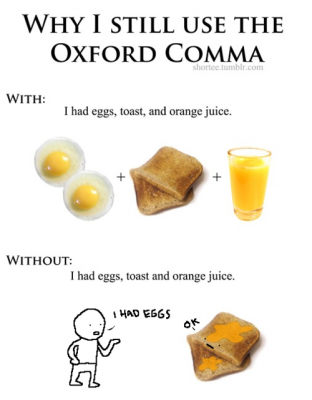I hate commas!
Well actually, that’s a lie. I don’t hate commas. Personally, I love them, but because I run a tutoring center, I hear this refrain all the time. And honestly, I understand why most people do hate them. If you are one of those people, you are not alone. I mean, really, why do we need commas anyway?

Well, here’s why…commas are the like a beat in a screenplay, a rest in music, or a quick timeout in football. They exist to tell the reader it’s time to take a breath. This is very important to keep readers from suffocating…okay, maybe not entirely true. Most of your readers are probably going to be reading to themselves. But what if they actually have to read out loud? Well then they’re doomed. And what if they read your work in their head the way they would read it out loud? Chances are, without commas, they’ll misunderstand what you’re trying to say or, at the very least, have to read the sentence a couple times before they really understand you.
Take this for example:
- “The aim of every artist is to arrest motion which is life by artificial means and hold it fixed so that a hundred years later when a stranger looks at it it moves again since it is life.” – William Faulkner
- Makes more sense this way: “The aim of every artist is to arrest motion, which is life, by artificial means and hold it fixed so that a hundred years later, when a stranger looks at it, it moves again since it is life.” – William Faulkner
So a basic rule of thumb is: When you read the sentence out loud, if it sounds like you need to take a breath, you probably need a comma there. Insert one; then check your sentence against these rules.
Remember that these rules exist to help writing approximate the rhythm of natural language.
Basic comma rules….
1. Items in a series: When listing items in a series (ie. three or more), put a comma after each item.
- Example: Chef Zink brought me chocolate mousse, an apple croustade, an éclair, and peach sherbet.
Disregarding the fact that I need to workout 24 hrs straight in order to get rid of all these calories, Chef’s desserts are a perfect series – there’s more than three of them, and they are all equally important in this thought.
The commas here could be replaced by “and”s…. Chef Zink brought me chocolate mousse and an apple croustade and an éclair and peach sherbet. Using commas allow us to take breaths in between the items and not bore our readers with lots of “and”s.
Some grammar and language experts say that because the commas take the place of “and”s, people should omit the comma right after the next to last item in my example above. Other grammar and language experts disagree (ie. People who like the “Oxford comma”). While either way is now considered correct, I am a fan of the Oxford comma, and this little cartoon will show you why.

There is another cartoon using JFK, Stalin, and some strippers, but I wanted to keep my site PG, so if you want to see that one, just Google image search “oxford comma JFK Stalin”. You’ll see what I mean.
2. Introductory words, phrases, or clauses: When a word, phrase, or clause comes before the subject of a sentence but adds information to the verb, put a comma after it.
- Example: Inevitably, you will have to present in Mr. Watson’s class. – Inevitably is an introductory word here that tells us how you will have to present in Mr. Watson’s class. The subject here is you.
- Example 2: Sooner or later, you will have to present in Mr. Watson’s class. “Sooner or later” is a phrase (a small group of words) that tells us how you will present in Mr. Watson’s class. Again, the subject here is you.
- Example 3: Whether you want to or not, you will have to present in Mr. Watson’s class. “Whether you want to or not” is a clause (a group of words that has a subject and a verb but doesn’t make sense by itself). This clause tells us how you will present in Mr. Watson’s class. And once again, the subject here is you.
Commas after introductory material can be confusing because it’s often hard to tell what is introductory and what is subject. Remember that the subject is always what the sentence is about – a person, place, thing, or idea or a word that indicates one of these (ie. he, she, it, you, us…) and all of the words that describe it.
3. Unnecessary Words: When you include information in a within a sentence that isn’t critical to the overall meaning of the sentence, you put commas around the group of words.
- Example: My computer, much to my surprise, worked perfectly all day.
This sentence makes complete sense without the words that are enclosed in commas – My computer worked perfectly all day.
“much to my surprise” gives you additional information, but it’s not critical to the overall meaning of the sentence.
The additional information that you would enclose in commas is like a “sidebar” or a comment from the author.
4. Compound Sentences: When you join two complete thoughts with a conjunction (and, but, or, for, nor, yet, so), use a comma after the last word of the first thought.
- Example: Josh tallied the scores for the skate contest, and Brandon helped him pick the winner.
There are two complete sentences here:
1) Josh tallied the scores for the skate contest.
2) Brandon helped him pick the winner.
But we don’t have to write them as two independent sentences. In this case (especially since they’re closely related – ie. Josh AND Brandon are about to make somebody’s day), it makes more sense and sounds better to put them together with the “,” and the “and”.
5. Addressing Someone by Name, Position, or Title: When you address a specific person in a sentence, enclose the name in commas, unless the name is at the beginning of the sentence. Then, just put a comma after the name.
- Example: If you want to join us by the fire, Josh, you know where to find us.
- Example 2: Josh, you know where to find us if you want to join us by the fire.
Setting the name off with commas, gives the reader the pause that you normally have when you’re speaking directly to someone. This lets the reader know that you are addressing a specific person rather than writing about him/her.
If you can master these five rules, you will have commas in the bag. Will you make mistakes? Sure. All of us, even publishers of books, mess up commas sometimes (even though we may not want to admit it).
Just remember – your reader needs air.
Leave a Reply